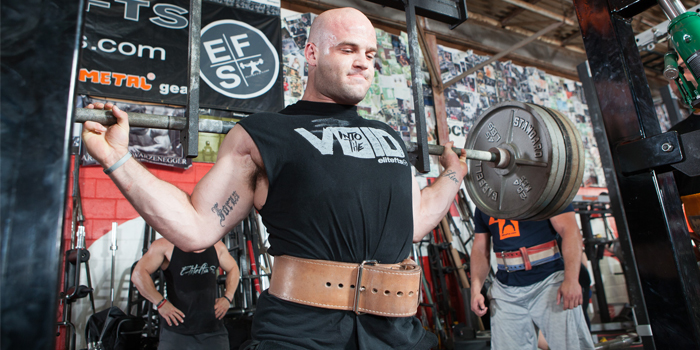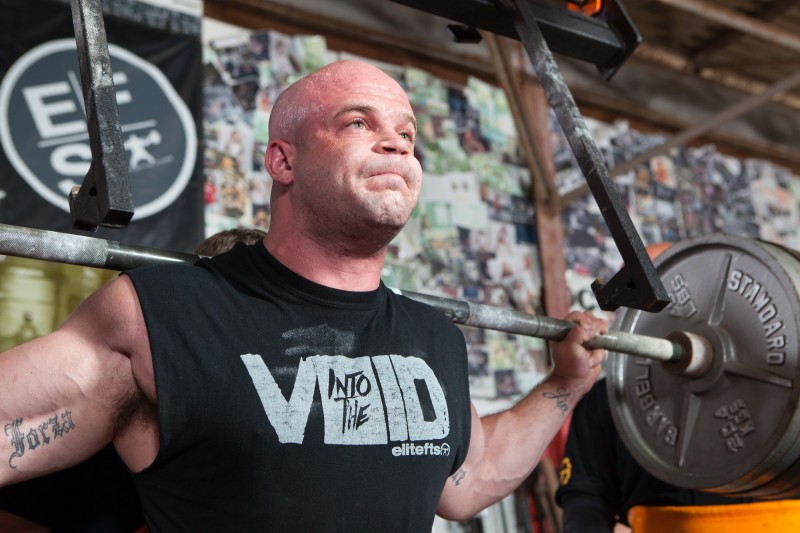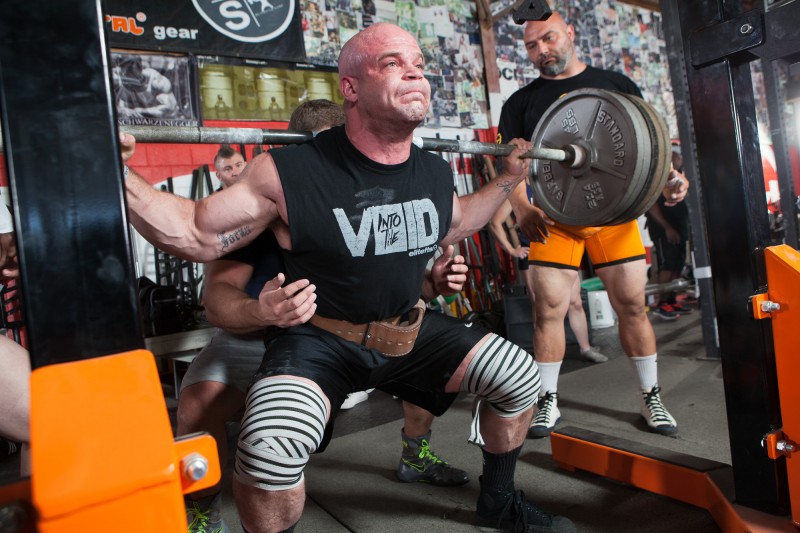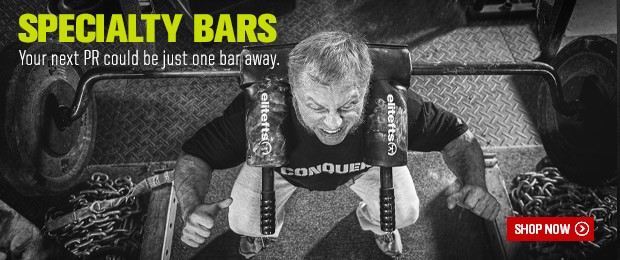
We’ve all heard the common squat cues countless times:
- "Sit back"
- "Knees out"
- "Spread the floor"
- "Drive the upper back into the bar"
- "Back tight"
- "Chest up"
- "Screw your feet into the floor"
- "Deep breath and brace hard"
Some are good cues, some not so good, all dependent on each person and how they internalize them. But do they really alter our movement? Well, that’s a yes-and-no answer. While I won’t say they do not work, I will say at times that they are not the optimal way to alter movement patterns in the competition squat when there are form discrepancies. I do believe that, when someone has good form and movement but needs a simple reminder of proper positioning, these cues can work great. But when things are just out of whack, telling someone to sit back in a squat over and over is not going to make them sit back, as they just simply do not have the ability to do so. And while some may argue that the issue could be due to a lagging muscle group, I will argue that many times it is neurological. Where this is very evident is in training the general population.
RECENT: Alternatives to Squat Training After Overuse Injuries
As a personal trainer, when I receive a new client who has never trained with weights before, there isn’t a lagging muscle necessarily; they are just weak all over. The typical new client squat is extremely knee-dominant, many times with little to no movement at the hips. Yet within two or three weeks, I can usually dramatically alter their squat pattern and have them now sitting back into their squat, getting their knees and hips to break and move simultaneously. Is this because they have all of a sudden made drastic muscular increases in their posterior chain in just three weeks? Most likely not. It is more likely that we have addressed deep-rooted movement discrepancies created by long-standing bad habits of being knee-dominant in daily life. It is more likely that we are reprogramming them to properly incorporate the posterior chain within the squat pattern.

How is this accomplished? By choosing the right squat variations to force them into the correct movement pattern. It is to no avail to tell this novice client to sit back in their squat unless I provide the proper variation to allow this movement to happen naturally. For instance, in this example that will be from some form of a box squat, most likely a goblet box squat once external loading of the movement is appropriate.
Now, the question is if this applies to intermediate and advanced level lifters or only to novice personal training clients. My answer is that it works for all lifters, to great success. While I do not want to discredit emphasizing accessory work for lagging muscle groups, I do not believe that is the end all, be all for fixing movement issues in the competition squat. Those lagging muscles must be strengthened, but incorporating squat variations that force lifters into the proper movement pattern we desire is a recipe for success.
So how is this put into practice? First, we must understand what movement qualities we would like to address in the competition squat, as that is what we are trying to fix. Let’s go over the most common problems people run into:
- Issue 1 — Good Morning Squat (Hips shoot up or back on the concentric portion of the movement, causing the chest to fall and leading to a “good morning” squat)
- Issue 2 — Knee-Dominant Squat (Knees break first and continue into flexion at a faster rate than the hips
- Issue 3 — Upper Back Collapse
- Issue 4 — Hip Shift (Left or right)
- Issue 5 — Knee Cave (Valgus, most commonly in the bottom position when concentric motion starts)
While there are more, especially if you start to account for faults in the ability to brace properly, these are the ones we most commonly see in regard to the actual movement pattern. You may have noticed I also left out issues with the bar path, which is a common thing talked about in regard to the squat pattern. The reason for this is that the bar path is not the root cause of any of these issues, but rather the outcome. Looking into each of these issues, the first thing to determine is where the problem is primarily occurring — either in the sagittal plane or the frontal and transverse planes of motion. Of those five common problems, the first three are issues regarding primarily the sagittal plane (issues that are occurring front to back). The fourth and fifth issues are primarily within the frontal and transverse planes (issues that are of some sort of combination of side-to-side and rotational).
Let’s take a look at issues four and five first, as there is basically one thing to do for these issues that really helps. While band distraction or some type of external resistance and/or cue could be very appropriate here, I am more interested in choosing a loaded squat variation that will help alleviate these issues. For that, the answer is tempo squat variations. This could be eccentric-only tempo variations or even adding in a tempo within the concentric. Either way, slowing down the movement (which forces you to drop the weight as well), and focusing on proper form through the eccentric and concentric is usually the best way to start reprogramming the body to stay within proper alignment. For the squat, this means zero side-to-side and rotational movement at the hips and knees. For the question of which squat pattern to choose to apply a tempo to, that depends on if there are any other movement issues. If hip shift or knee valgus is the only issue, applying that tempo to the competition squat would be a great start. However, if any of the first three issues are present as well, we can double up these variations to kill two birds with one stone.
Looking now at the first three issues, we have a lot more to work with here. We know the issue is happening in some manner front to back, whether we are traveling too forward in the squat, pushing back too much into the hips, flexing at the upper back, or flexing at the lumbar spine. Whichever the issue may be, our goal is to find a variation that challenges this issue. The first place we can start is bar placement. Generally, the more anteriorly loaded the squat variation is, the more it is going to place us in a knee-dominant position. And the more posteriorly positioned the bar is, the more that variation will place us in a hip-dominant position. Let’s start with issues number one and three, being that the hips shoot up causing the chest to fall and creating the “good morning” squat and/or the upper back collapses, as many times these occur simultaneously. These problems can be addressed by doing two things: First, choose a variation that is more anteriorly loaded, assuming you are in a low bar position, which tends to also challenge the upper back more. Second, add variations of pause and pin squats that reinforce better positioning out of the hole.
RELATED: Bracing and the Hip Hinge
To give a specific example of a squat variation that would tackle this issue, assuming you low bar squat, we will look at a high bar pin squat. High bar positioning is going to force you into a more upright position and extend the moment arm of the bar in relation to the hips, challenging the upper back to a greater degree. Then adding in a pin squat variation to this movement, you are now placed in the bottom position, where if you shoot your hips up the movement will be infinitely harder. What does your body naturally want to do then? It wants to stay more upright, keep the hips down, and maintain upper back tightness. If you don’t, the movement is going to feel extremely awkward and, due to the increased difficulty, you will get immediate feedback that your form was wrong. Using this now as a variation within your training, you can start to alter your movement pattern of the hips shooting up and upper back collapsing by using high bar pin squats to enforce the position we want, which will translate into changes within the competition squat.

For the opposite problem—the second issue on the list—where you are knee-dominant within the squat and need to improve the recruitment of your posterior chain, we are looking to do the exact opposite of the above. Here we want to load the bar in a posterior position and force the body into a movement where we need to sit back more and reaffirm positioning in the bottom portion of the squat. For this, box squats or adding in a pause will do the trick. People like to have a target, and even though they have the ability to sit back into their squat, there is subconscious hesitance due to instability and the thought that they might lose their balance and fall back. Once you place a box there, this hesitance usually goes away. Once they become accustomed to the box and show the ability to control their tempo through the entire range of motion, not just plopping down on the box, then it’s time to take the box away and introduce that same movement pattern with a pause at the bottom.
While for issues one and three a pause variation can help, I usually prefer a pin squat to address issue two, as that slight drop in tension at the bottom of a pin squat is great for reinforcing a proper up-and-down bar path. For issues one and three, pauses seem to work better due to the tension that must be held at that bottom position, particularly in the hips. If you force someone to pause at the bottom and they are extremely knee-dominant, it will not be the most comfortable movement, but once they properly involve the hips, it is a much more comfortable position that reinforces the recruitment of the hip extensors. Continually practicing this positioning then starts to translate into a better competition squat, where the hips and the knees move simultaneously and the biggest muscle in the body, the gluteus maximus, is now properly utilized.
With the specific issues and solutions listed above, we can now also look at a number of additional variations that I have seen address the issues. This is not a one-variation-fits-all scenario, so if the above does not do the trick, consider some of these variations instead. Everyone is different, so the appropriate variation must be chosen for the individual.
Issue 1: Good Morning Squat
With this issue, the hips shoot up or back on the concentric portion of the movement, causing the chest to fall and leading to a “good morning” squat.
Variations:
- High Bar Squats: These force the torso into a more upright position, increase the use of the quadriceps, and decrease the reliance of the posterior chain.
- SS Yoke Bar Squats: This is the same as high bar squats, but due to the SS Yoke bar now being even farther away from the hips because of the pad height, there is even more negative feedback when the hips shoot up, really forcing you to have to stay upright.
- Pin Squat Variations: There is a slight decrease in tension at the bottom, which forces the body to find the optimal approach to regain that tension and produce strength and acceleration out of the hole, usually forcing a more upright position.
- Pause Squats: Due to the pause, you have that slight instant to reinforce thoughts of proper movement versus that immediate drive out of the hole. This allows you to emphasize the common external cue of driving the upper back into the bar.
- Front Squat: This is listed last as it is my least favorite, and I rarely program this for powerlifting except in extreme cases. Due to being so anterior-dominant, I usually see this movement force someone into such a knee-dominant position that it is detrimental. I have found those who front squat on a regular basis tend to lose balance towards the toes on the concentric portion of their competition squat, which is even more of an issue than the hips shooting up and back, as we are weaker in that anterior-dominant position.
Issue 2: Knee-Dominant Squat
With this issue, the knees break first and continue into flexion at a faster rate than the hips.
Variations:
- Box Squats: This adds a target to sit back to, taking out the subconscious hesitance to sit back due to fear of instability and losing balance. Box squats train the body to utilize the posterior chain in the correct manner through a controlled full range of motion.
- Pause Squats: This movement helps to reinforce positioning at the bottom, and due to the increased difficulty of holding that isometric position, it forces the body to want to utilize the proper stabilizing muscles in the hips to ease the difficulty of the movement.
Issue 3: Upper Back Collapses
Variations:
- High Bar Squats: These increase the moment arm between the bar and the hips, creating more tension in the upper back. If the upper back collapses there is immediate and uncomfortable feedback, as the bar will try to roll up the neck, cueing you to want to maintain upright positioning to reverse that issue.
- SS Yoke Bar Squats: These are the same as high bar squats, but to even a greater degree. You do have to be careful with safety bar squats, though, as it is common to see people squat every rep with a round upper back, which may do the exact opposite and start to further the issue. Make sure to maintain proper spine alignment and to treat upper back rounding as a failed rep if the goal is to fix the issue of upper back collapsing.
- Pin Squat Variations: As with the hips shooting up or back, with pin squats that slight decrease in tension at the bottom cues the body to tighten up at the start of the concentric, or else the movement gives immediate feedback due to the increased difficulty of accelerating out of the hole.
- Pause Squats: Just like with the hips shooting up or back, due to the pause you have that slight instant now to reinforce thoughts of proper movement out of the hole. This allows you to emphasize the common external cue to drive the upper back into the bar and keep tightness in the thoracic spine.
- Front Squat: This greatly challenges the upper back, but as mentioned above, this variation may actually cause too much of a change to where you now have the exact opposite issue.
Issue 4: Hip Shift (Left or Right)
Variations:
- Tempo Squats: These reinforce proper bracing and stabilization throughout the movement. It is much easier to maintain proper position as you slow the movement down and decrease the weight. Also with the movement being slowed, it is easier to make quick adjustments during the movement when you feel form break.
- Pause Squats: Due to the tension needed in the bottom position during a pause squat, and also the increased time to process external cues, these help to reinforce proper form during the concentric.
Issue 5: Knees Cave
With this issue, the knees cave in (valgus), most commonly in the bottom position right when the concentric motion starts.
Variations:
- Tempo Squats: These reinforce proper tension at the hips throughout the movement and, as mentioned, it is much easier to maintain proper position as you slow the movement down and decrease the weight. These also allow more time to process external cues and keep the knees out throughout the movement.
- Box Squats: These can be beneficial in regard to knee valgus, as they force a hip-dominant position that cannot be attained without proper tension in the hip abductors. Using box squats and a tempo really forces you to maintain abduction at the hip to be able to control the movement through the full range of motion.
- Pause Squats: This variation allows you to get immediate feedback on the difference in tension from right to left and then correct before initiating the concentric motion. Also, same as above, due to the tension needed in the bottom position during a pause squat, and also the increased time to process external cues, these help to reinforce proper form during the concentric.
This article was not intended to give you the exact answer of how to fix your squat, but instead, give you some new ideas on how to approach fixing movement issues through squat variations. It is now your goal to take these thoughts, analyze your squat, and see what variations you could apply within your training to improve your squat pattern.
Steve DeNovi is a Personal Trainer, Powerlifter, and Strength Coach from Springfield, MO specializing in strength athletics and post-physical therapy rehabilitation through his company Progressive Resistance Systems. For further questions, you can contact him at sdenovi@gmail.com and visit his website prsontheplatform.com.










Thank you for sharing.
Thanks